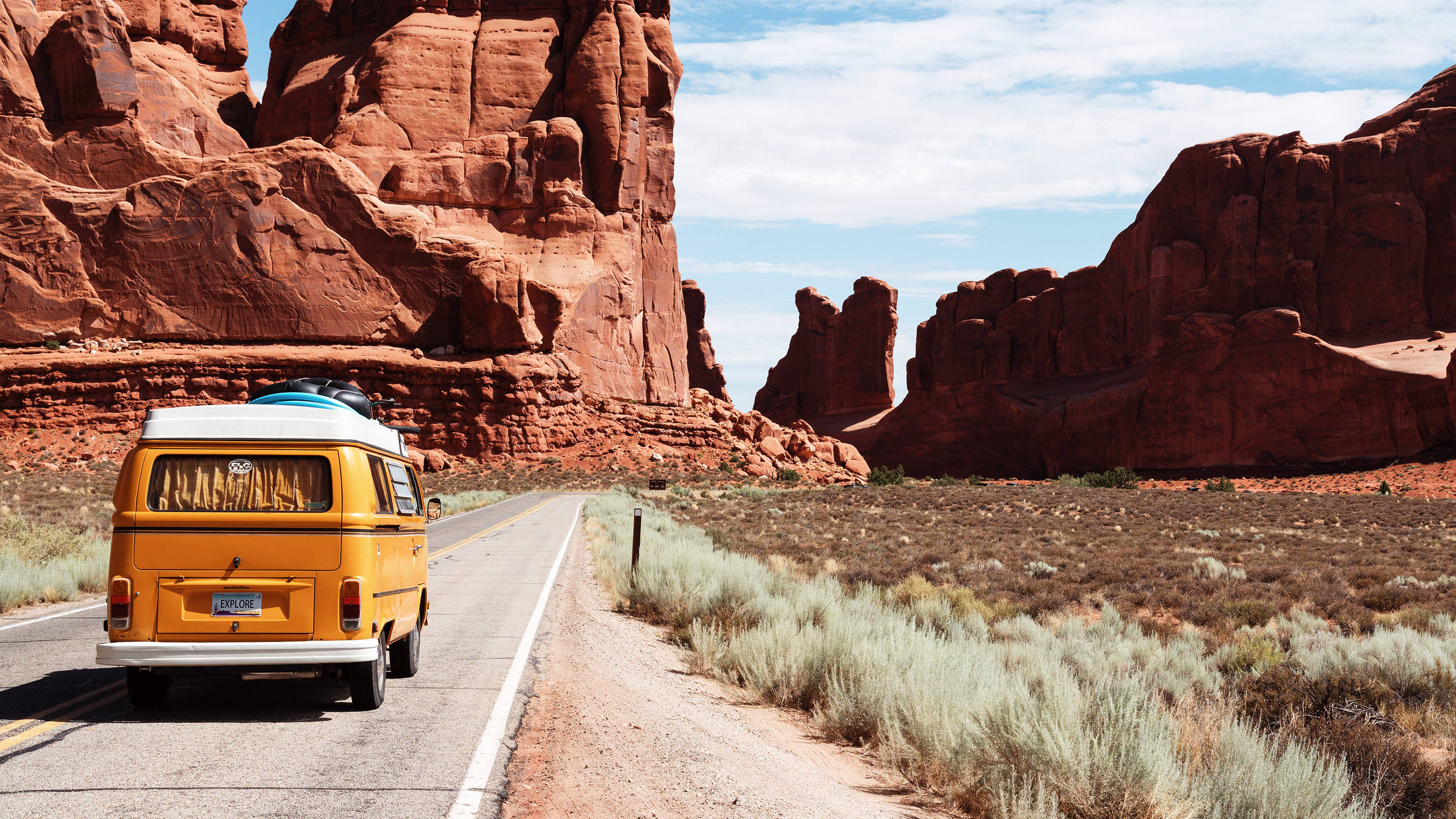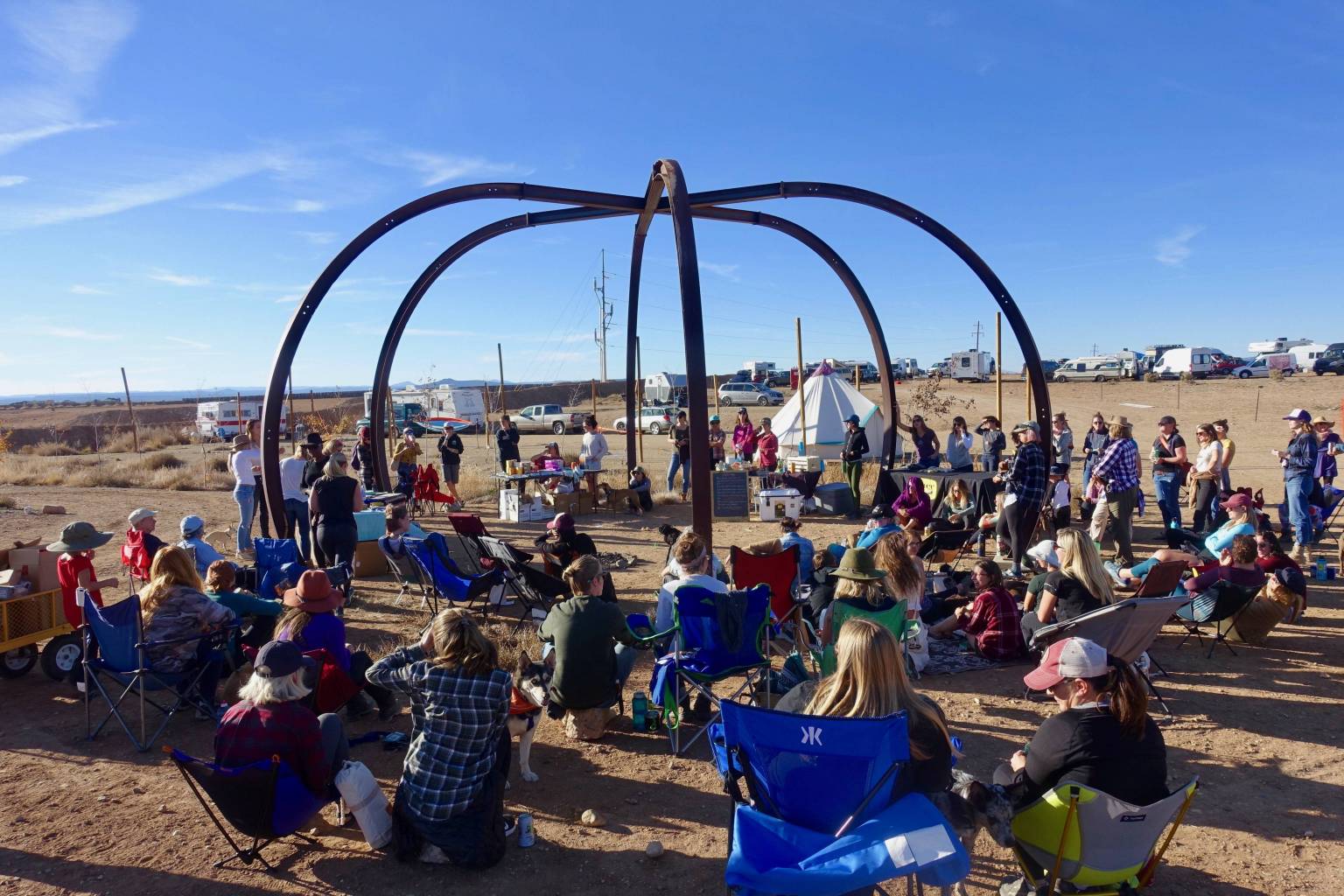
Are Roving RV Neighborhoods the Future of Community?
In New Mexico's high desert, a society of nomadic women seek independence through nature
I peered into the windows of many vans while driving from Portland, Oregon to Taos, New Mexico. My head would instinctively swivel as my Subaru passed the much larger vehicles on long, quiet roads. Was there a woman at the wheel?
Hotel Luna Mystica—a collection of vintage trailers parked on a flat expanse of New Mexico, backed by the snow-capped Sangre de Cristo Peaks—was my destination. The property was hosting the Women on the Road Gathering, a weekend congregation of more than 100 women and gender non-conforming individuals who live nomadically in campervans, RVs, trucks, even cars. Women on the Road is primarily a podcast about women who live in their vans, hosted by Laura Hughes who often records and produces the show from her own van. But it’s also a community that extends across social media channels. They partnered with Vanlife Diaries, which regularly hosts “vanlife” meetups, for this womxn-only iteration.
Many would arrive alone, as I would. Some would arrive in a string of homes on wheels; conga lines of white and black Sprinters and decades-old vanagons rocking back and forth over the pot-holed landscape to form circles of temporary neighborhoods on the far end of the property. They would come to see old friends, meet new ones, and bond over a desire to create lives that might look a little strange to those with a fixed address.
“Little girl, you shouldn’t be alone in a van.” Lisa Jacobs almost believed her ex-boyfriend. Coincidentally, he delivered this line over the phone while Lisa paced these very premises, exactly one year before the first day of the gathering. Lisa and her ex had renovated a 2012 Nissan NV2500 with a high roof and 50,000 miles, which they bought off Craigslist for $11,000. They would live and travel in the van while launching a business in campervan renovations. But the two split before they could do any of that.
It’s an inspiration board for anyone who might want to live this way; buy the van and quit the job and you, too, can open your back doors and watch the sun rise over the ocean with a dog or a very attractive human at your side.
“Little girl...” She laughs now when she recalls that line, staring off into the mountains. The temperatures dipped below freezing on the first night of the gathering, but now we’re sitting outside of an Airstream in tank tops and sunglasses. Soon, panels and group activities would fill the day.
“I have a lot of respect for people who do this solo from the start,” she tells me. “I don’t think I ever would have if I hadn’t been sort of forced into it.” When Lisa returned to Austin, post-breakup, she wasn’t sure what she’d do with Freebird—until another woman in a van showed up at her doorstep.
When “vanlifers” aren’t meeting in remote high desert towns, they can often be found gathering digitally on Instagram. Search for “#vanlife,” and you’ll see more than 4 million photos of people and the vans they call home. It’s an inspiration board for anyone who might want to live this way; buy the van and quit the job and you, too, can open your back doors and watch the sun rise over the ocean with a dog or a very attractive human at your side. But beyond the plasticy tropes that pop out of the most popular posts, there’s a community here. People who live in their vans connect through comments and direct messages, and sometimes their paths cross in cities and campgrounds and public land around the country.
Lisa (@vacayvans) had connected with Jess (@van.there) on Instagram first, then received an email that Jess would be coming through Austin. Hours later, a Sprinter was parked in Lisa’s driveway.
“You can do this,” Jess told Lisa at a time when that’s all she needed to hear. So she did. Lisa moved into her van in March of 2018 and has been traveling solo ever since. Lisa and Jess are now IRL friends, and the two arrived at the Women on the Road Gathering together with two other women in an RV much bigger than the vans they left elsewhere.
Meeting Lisa was a relief. I spent a lot of time avoiding the Women on the Road Gathering the day prior. I stopped at a park on the banks of the Rio Grande on my way from Santa Fe and journaled while my dog chewed sticks beneath the lemon-yellow leaves of an aspen grove. Then I stopped for a beer—I was already missing the check-in window—yearning for a little more alone time before joining this throng of women and their vans (and many other dogs, too.)
I find big gatherings of people exhausting. But Lisa was easy to talk to. And the night prior had already revealed something obvious about this community. A lot of us like to be alone. But it’s also a relief when you can congregate with people who get it—especially other women.

Between songs, she spoke lightly of heartbreak, lonely nights on the road, and pooping in the woods. We laughed and nodded and felt like we knew her. Wolf’s road trip songs echo a very American story—hitting the highways and byways in search of adventure; seeking solitude, opportunity, or freedom, but inevitably looking for love. I tried to read Jack Kerouac’s iconic On the Road before this trip. I wanted it to mirror my own desire to drive and drive and drive. But on my third attempt over more than a decade, I found it impossible to finish. Why were the women always portrayed as obstacles to leave behind? Didn’t they want to go somewhere, too? Dean and Sal never would have sat still long enough to enjoy Ira’s soothing voice and poignant lyrics.
The women who gathered in Taos are living their own road trip narratives—even though a recognizable storyline for women hitting the road on their own is hard to find. Solo women travelers are still suspect. We’ve all been asked, incredulously, are you traveling alone? Are you safe out there? What if something happens?
“I love going to little towns in the middle of nowhere,” Lisa tells me. “It’s fun surprising them. People don’t expect a girl with pink hair to pop out of that big van.”
I felt my heart settle into the familiarity of Wolf’s lyrics. We all sipped on wine and rocked back and forth. Some wiped away tears. We recognized ourselves in the music and in each other.
The following day there were panels on safety and sexism. We broke into small groups to talk about topics that follow us from place to place. You can leave town, but you can’t leave the frustrating fact that women face risks on the road that men never think about.
I love going to little towns in the middle of nowhere. It’s fun surprising them. People don’t expect a girl with pink hair to pop out of that big van.
“Oh, yeah,” said several in unison, chuckling as if the question wasn’t worth discussion, because yes, of course. When you’re a woman who’s alone on the road, and you find yourself camping next to a man (or worse, a group of men) your gut instinct is to be on guard. But here, we can relax and talk about whether or not we should install a toilet in our vehicles, how to find safe places to park, and how men never expect us to know anything about the mechanics of our homes. (Still, I admit that I know nothing about the mechanics of my car. I swear by AAA.)
When someone asked if anything scary had happened to any of us while traveling alone, one woman began to share—then shook her head.
“I was followed…for a long time,” she choked out, and then she started to cry. Hands instinctively went to her back for comfort. Some people looked away.
I left after the panels while others gathered for a raffle of outdoor gear and pulled layers back on for the second night. I had 2,000 miles to cover in the next three days as I completed a cross-country trip to my parents’ house in Connecticut. Hours later, with Ira Wolf on Spotify, I found myself rumbling through a deep sand road, cutting across vast ranchland in a dark corner of Colorado. Rabbits sprung out from the brush, bursting across my headlights in a panic, and my shoulders crept up to my ears with anxiety. I had been looking for a free campground, but I should have turned around when the road turned to sand. I flipped on my brights, which only served to illuminate how much I couldn’t see.
“I’m safe,” I told myself. “I’m fine.” And I was. But I was also scared. My wheels spun out and spat sand in all directions and I decided to turn around and find a motel. I thought about the other women I’d just met and left in Taos. I knew they were safe, gathered together around campfires. And that they’d probably, at some point, get stuck on dirt roads elsewhere. And they’d probably be just fine. That’s how the road goes. We can’t prepare for it all, but I look forward to crossing more paths and sharing more stories with all the women who keep going.
Heartbreak in 100 Square Feet: Why Living in a Van Is Now Aspirational
The #vanlife movement tempts many couples with its glamorized alternative to the American Dream







